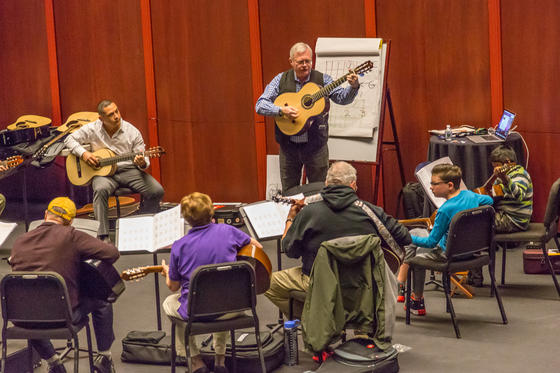In This Story
Since 2014, the Veterans and the Arts Initiative at George Mason University has reached over 16,000 military-connected community members by offering everything from hands-on workshops to art exhibitions and concerts—all designed with Veterans, Service members, military family members, and military caregivers in mind.
What began as a modest effort to offer gratitude to Veterans each Veterans Day by providing a creative outlet at the Hylton Performing Arts Center in Manassas, VA has grown into a thriving hub—a place where art meets community, providing a much-needed space for the military community.
What sets the Veterans and the Arts Initiative apart is its knack for building more than just artistic skills—it's about bringing people together and creating a community that feels like a second family, which is often hard to find after leaving the military.

"This program brings Veterans of multiple generations and their families together," says DK Stewart, a longtime participant and U.S. Air Force Veteran. "It provides a place for camaraderie and shows appreciation to our Veterans. It's a place where we can connect, create, and feel valued."
The program isn't just about art classes; it's about creating a space where Veterans and their families can explore creativity as families, as friends, and as people sharing similar experiences and impacts while they are active-duty, Reserve or National Guard members, and beyond. These shared experiences don’t just paint pictures—they forge stronger family ties and build lasting connections.
At its core, the Initiative is guided by George Mason University's pillars of diversity, inclusivity, grit, and audacity. These pillars shape its mission to create a welcoming environment for all military-connected individuals, regardless of background or artistic experience.
Diversity is a fundamental aspect of this program. It embraces Veterans and their families from all backgrounds to enrich the learning experience with a variety of perspectives. This inclusivity facilitates personal development and deepens connections among participants.
One of the participants, U.S. Marine Corps Veteran Dawn Harrison, said: "Being around other creative people has given me the inspiration to find my own creative style. The programs have provided a creative outlet for me, and I want to use my creativity to establish myself as an artist."
The program's commitment to inclusivity is clear with an open-door policy that says, 'Come as you are.' Whether you're a seasoned artist or picking up a paintbrush for the first time, there's a spot for everyone. This approach allows participants to express themselves through art and find their place within a supportive community.
Harrison reflects, "I have been able to meet other Veterans who also have an interest in different art forms. I have learned more techniques and gotten new ideas to create things." This openness helps participants connect, learn from one another, and build a robust, inclusive network.
Despite being run by a very small but dedicated team, the Initiative shows grit through its consistent and impactful programming. Many workshops and classes are led by faculty from the School of Music and the School of Art, who provide their time and expertise beyond their regular teaching duties.

Glen McCarthy, a guitar and ukulele instructor, reflects on the program's resilience during the pandemic: "When COVID-19 shut everything down, we immediately moved our guitar classes online. The Initiative continued to grow and thrive, demonstrating our commitment to our participants." This ability to adapt has been vital in keeping the program accessible and thriving.
The Initiative's audacity shines through its innovative approach to supporting Veterans and their families through the arts. Integrating creative programming and conducting impactful research informs national organizations, making a difference in the lives of millions of Service members and their families. "I know that all of the programs under the leadership of Dr. Niyati Dhokai will continue to flourish," says McCarthy. The program's reach extends beyond the university, serving as a model for similar initiatives nationwide.
The Veterans and the Arts Initiative is distinguished by its holistic approach to supporting the military community. It's not just about creating art; it's about using creativity to build connections, foster well-being, and empower individuals. Programs like the “Veterans Guitar Workshop Series” and “Creative Writing for New Beginnings” offer more than just new skills; they provide Veterans and their families with opportunities to find new purpose and build relationships in a supportive environment.
The Initiative also recognizes the unique needs of different groups within the military community. Programs designed specifically for women Veterans, like those highlighted by U.S. Navy Veteran Rhonda Honegger, ensure everyone feels seen and supported. "There's a tendency for our service to go unacknowledged and unseen," Honegger says. "To have a space that makes a specific effort to gather women who served is invaluable."
This focus on inclusivity creates a welcoming environment for all Veterans and their families, providing tailored support for those who might otherwise feel overlooked.
Celebrating a decade of service and creativity, the Veterans and the Arts Initiative isn’t slowing down. With eyes set on the future, the program is determined to reach even more Veterans and families, deepening its impact through the arts.
As the Initiative moves forward, it will continue to reflect George Mason University's core values, standing as a vital resource for the military community and setting an example for arts programs nationwide. For many Veterans and their families, this Initiative is far more than a series of workshops—it's a supportive community, a space for creative expression, and a chance to rediscover a sense of purpose.
